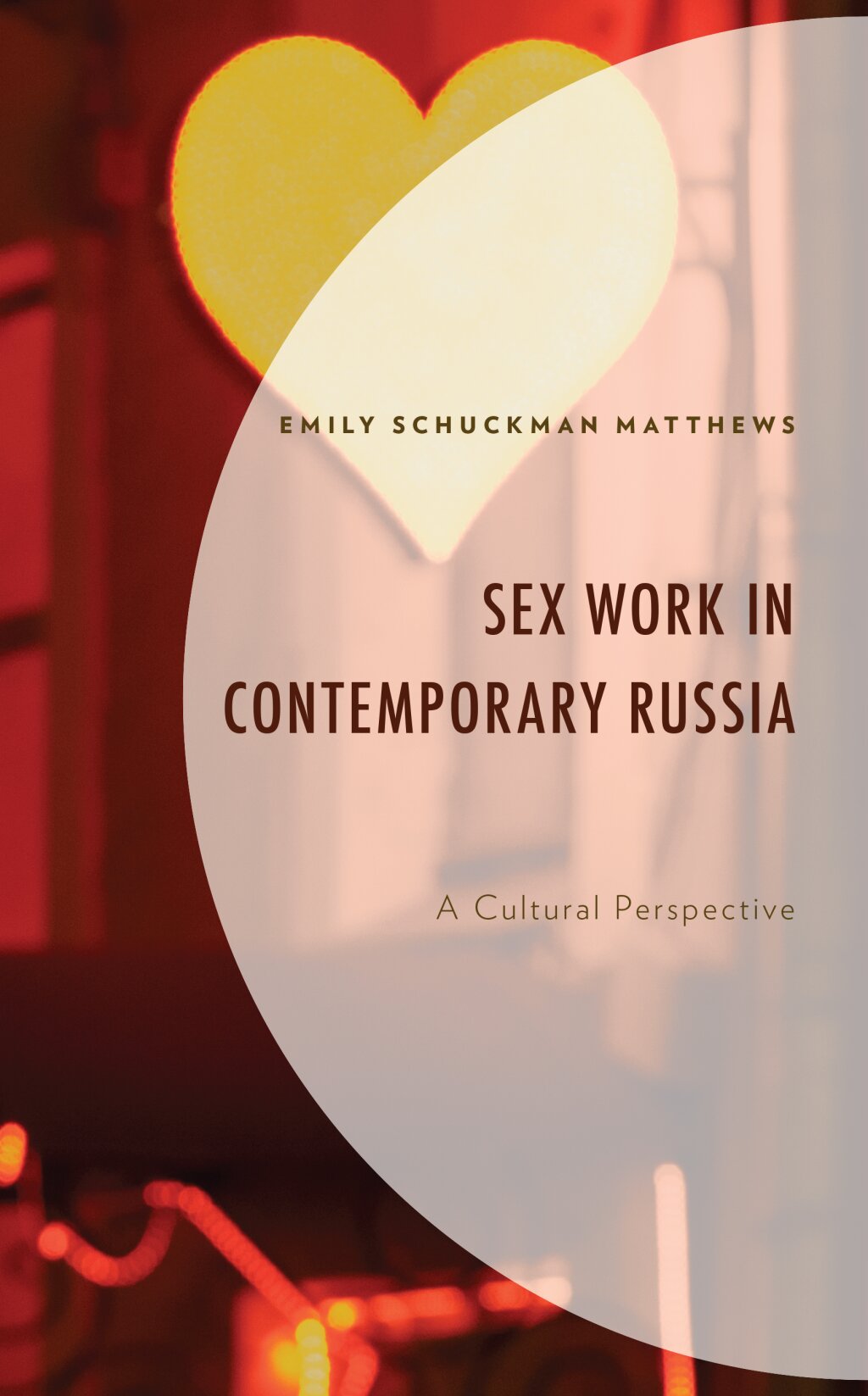The Jordan Center stands with all the people of Ukraine, Russia, and the rest of the world who oppose the Russian invasion of Ukraine. See our statement here.
This week, the Blog is pleased to feature a three-part series of excerpts from Emily Schuckman Matthews' Sex Work in Contemporary Russia: A Cultural Perspective, out now from Lexington Books. This is Part II; Part I may be found here, and Part III will follow tomorrow, 3/23.
Emily Schuckman Matthews is associate professor of European Studies at San Diego State University.
Definitions and legal status of prostitution in Russia
The 2003 issue of the Concise Russian Encyclopedia (Kratkaia Rossiiskaia entsiklopediia) defines “prostitution” (prostitutsiia) as “the sale of one’s body (predominantly by women).” I will adopt the same basic definition as well as interpret the sale of one’s body to mean exchanging sex for currency, material goods, or social favors. Though male prostitution does exist in Russia and deserves more scholarly attention, this book will focus on representations of female (and female-identifying) sex workers. I will also use both the terms “prostitute” and “sex worker” to describe women who engage in transactional sex.
Among feminists, these terms can be fraught with political implications denoting a person’s stance on transactional sex as inherently exploitative (prostitution) or as legitimate work (sex work). While I acknowledge this tension, my use of terms should not be interpreted as endorsing these associations. I employ the term “prostitute” frequently in part because in Russian, the terms prostitutsiia and prostitutka are most commonly used to describe transactional sex. While these terms are often used in a neutral context, they are also often employed to deride not only women who engage in transactional sex but sexually liberated and transgressive women more generally.
In fact, the Russian language is rich with words used to denigrate these women, euphemistically describe sex work and/or to highlight the specificity of the type of transactional sex in which they are engaged. The term seks rabotnitsa (sex-worker) is also used in Russia, though not nearly as widely. It is increasingly employed by some feminists who believe transactional sex should be viewed like any other form of legitimate work and/or argue for the decriminalization of sex work. The term is rejected by other feminists who view the sex industry as exploitative for women. In my research, I have learned that there is no binary division of the industry into fully positive or fully negative, but, as reflected in the primary and secondary sources I choose, a full spectrum of views reflecting sex workers’ complex lives. Those who enter the sex industry do so for a multiplicity of reasons, have a range of experiences from empowering to abusive, and represent a diverse group of people.
I attempt throughout the book to maintain a non-judgmental stance toward those engaged in transactional sex and, as often as possible, to incorporate the experiences of real-life women to enrich the readers’ understanding of the sex industry and to infuse fictional narratives with authentic voices. There are several million women working in Russia’s sex industry today. Prostitution is a misdemeanor offense in the Russian Federation with a maxi mum punishment of a 2,000 ruble fine. Article 240 of the Criminal Code, “Attraction to Prostitution,” punishes those who recruit individuals to prostitute themselves or compel that person to continue prostitution. Violating this article can carry a fine of up to 200,000 rubles. If force is involved, a jail sentence may be imposed. Article 241, “Organization of Prostitution,” states:
The deeds aimed at the organization of prostitution, as well as at the maintenance of hangouts for prostitution or the systematic provision of premises for prostitution shall be punishable by a fine in the amount of 100 to 500 thousand rubles. Individuals convicted of committing this crime through an official position, with violence or with a minor, may be punished with jail time.
As in other places, sex work in Russia exists in a wide range of economic contexts. Top-tier prostitutes can earn lucrative salaries for services provided to elite, sometimes foreign, clients either on a regular basis or in high-end massage parlors and hotels. Others work through agencies and service clubs, massage parlors, hotels, or visit clients at home. Less affluent work takes place on the street, in private apartments, and on highways or at train stations. The sex industry in Russia is multiethnic with scholars estimating a significant number of female migrants (from Eastern Europe, the Caucasus, and Central Asia) working as sex workers, especially in large cities like Moscow. Despite this diversity in real life, the sex workers (and their clients) featured in films and literature are almost exclusively depicted as white, ethnic Russians.
It is not difficult to locate the commercial sex industry in the country. In addition to internet-based advertising and online escort sites, people on the street are bombarded with advertisements for sexual services, whether through the posting of sex workers’ names and numbers in public places or at more established venues such as hotels, massage parlors, and saunas. When visiting Khabarovsk in 2006, brochures placed in my room included a glossy magazine, “Rest and Entertainment,” which contained several ads for such venues and included numerous images of bikini or lingerie-clad women lounging next to a pool, pole-dancing or wrapped in towels, and sipping tea with male patrons. The ads note that these facilities have such amenities as “a dance pole” and that patrons can “order a performance by a show-group.”
Theoretical frameworks
I use the plural “frameworks” to describe the theoretical underpinnings of this book, as one single approach proves insufficient for investigating the multitude of ways this dynamic character can be represented and interpreted. One concept informing, though not dominating, my analysis is Michel Foucault’s work on the role of sexual discourse in society. He writes:
The central issue . . . is not to determine whether one says yes or no to sex, whether one formulates prohibitions or permissions, whether one asserts its importance or denies its effects, or whether one refines the words one uses to designate it; but, to account for the fact that it is spoken about, to discover who does the speaking, the positions and viewpoints from which they speak . . . What is at issue, briefly, is the over-all “discursive fact,” the way in which sex is “put into discourse.”
His theories on “power” are also critical: “Power is everywhere; not because it embraces everything, but because it comes from everywhere.” The editors of Sexuality and the Body in Russian Culture interpret “sex,” “sexuality,” and the “body” to mean “not biologically precise events or objects in the physical world, but (following Foucault), rather discursively constituted and changing entities that people have imagined and lived with in various ways throughout Russian history.” This is particularly applicable in the study of the sex worker. Throughout Russian history, the prostitute is often the verbal, visual, and literary site for this discourse on (primarily female) sexuality. While historically these representations have been the product of the male imagination, there are more and more women involved in crafting representations of the sex industry.
I employ a feminist reading of the materials selected and utilize a variety of theorists to reflect the expansive range of feminisms in Russia. Feminist thought in Russia does not easily track formally defined “waves” but, borrowing from Alison Dhal Crossley, is “waveless” in its fluidity and the wide range of voices represented. In her look at feminist writing in Russia, Marja Rytkönen notes that “‘feminism’ as such is not an unambiguous concept, but that there are several ‘feminisms,’ with different focuses, experiences, and aims.” Especially important to this book is the work of Aleksandra Kollontai, whose insights into Russian/Soviet women before and after the revolution feel as relevant today as they did when she was writing more than a century ago. Chapters 6 and 7 of my book also profile artists, activists, and others in Russia who contribute to the polyphony of contemporary feminist voices in the country today. I also draw on the important work on gender and feminism in Russian culture done in the past several decades by scholars globally.
Judith Butler’s concept of gender as performance is critical to my understanding of gender and sexuality, particularly in the realm of commercial sex. I also turn to Freud to interpret a 2006 film that engages with psychoanalysis to understand the male protagonist’s sexual frustrations (Chapter 3). My film analysis often employs the work of feminist scholar Laura Mulvey and her contributions to the understanding of “viewing” women in film. In terms of the female consumers of these works, I utilize Mary Ann Doane’s work on cinema, which illustrates the ways narratives allow women to identify with the female prostitute and thus to explore their own sexuality or position in society. The satisfaction these works might also offer female and queer consumers eager to expand their understanding of sex also allow them to enter what Michel Foucault describes as the empowering discursive space of sexual knowledge. Andrea Dworkin’s, Brian McNair’s and Linda Williams’ writings on pornography and what McNair calls the “pornosphere” also inform my discussion of these issues. Finally, Rosalind Gill’s work on post-feminism has greatly helped me understand and think about various feminisms and feminist-identifications.




